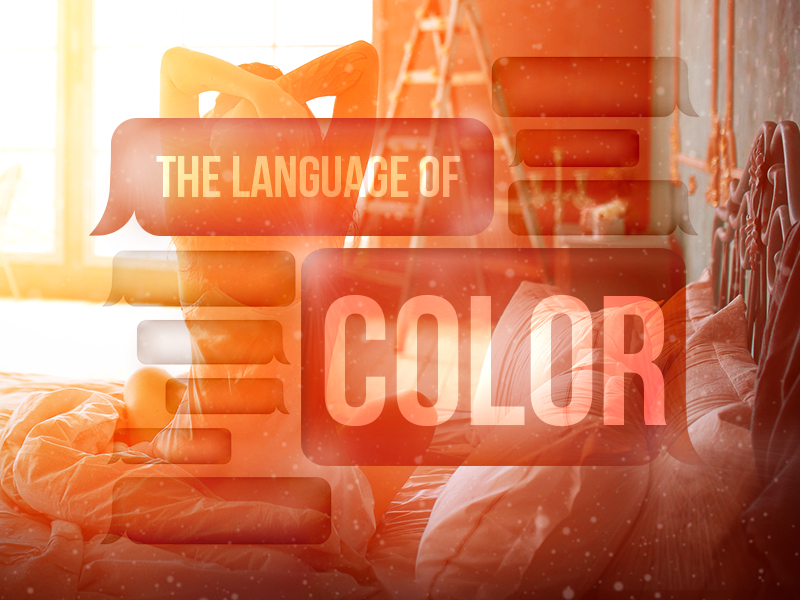When we look at color not just from an artistic stance, but from that of a marketer, color is a reinforcing voice that helps drive prospects to a business subliminally. Colors have the powers explained above to create emotional responses that can sway potential customers’ behavior to make decisions on a service, product, company value, and identity. Colors are more powerful than most people realize. Colors can have the same and even at times more impact than that of an image or message. The color alone can trigger a split second response, faster than comprehending what a brand is trying to say. So this is where creating a good first impression really is key.
The Language of Color
Thin rays of light stream across the floor between the blinds. The small particles of dust, dancing aimlessly across the avenues of light to the soft melody of an awakening Sunday morning. You rub your eyes and carelessly watch the quickstep of flecks whisping past one another, glimmering in the light as they showcase their moves. You see the English maple wood floors and the rich textures of the wood grain striping their way across in some sort of controlled chaos. Looking up, your heavy navy curtains and white blinds are the controllers of the spotlights for they dust dance happening at the foot of your bed. Your world, even in the quietest of moments, is full of life. Your world is full of color.
All these colors we see in the early Sunday morning when we finally crawl from the warmth of the bed to make that dark, rich cup of coffee, to the brilliance of the fresh green lawn as we take our dog out to bound around, create the world as we know it. We comprehend color through the transmission of nerve impulses from light receptors in the eyes to the brain which created perceived color. The nature of a color is created through the actual reflection of certain wavelengths of light. These reflected wavelengths are then what the light receptors in the eyes collect and transmit for our minds to process.
With all this information being passed to our brains continuously, we receive it, comprehend it, and react. Color, like any other language, is speaking to us. We see certain colors and it evokes emotional responses, even when we don’t mean for it to. Just like reacting to an overheard comment in a passerby’s conversation, you weren’t actively thinking to react, you just did. Color is always speaking, and we are subliminally listening.
Color creates emotion. But how?
Through conditioning in life and years of exposure to nature, culture, teachings, and experiences, colors create emotional responses. Think about bright, flashing red lights. You think to stop what you are doing or slow down. Those RED lights evoked fear, danger, panic, warning. You had an emotional response. Again, now think of fire. Fire is reds, it’s oranges, it’s yellows. It makes you feel warm and cozy, but if you put your hand in, it’s hot and dangerous. You have experienced another emotional response both of joy and fear from the same colorful thing. Colors are speaking to us, all we need to do is listen.
Each color carries within it unique qualities: deep or light, vibrant or subdued, a color’s tone can change how we feel. Generally, in a major color breakdown, colors can be associated with overarching emotions with different degrees depending on the tones, tints, and shades of each color.
Red
Red, as described earlier, is an instinctive color, one of danger. It overwhelms us with a sense of urgency. This urgency doesn’t have to just mean danger though. It can also mean a strong passion, a color of burning romance. Its intensity lends itself to that of urgent, deep, powerful emotional responses whether good or bad.
Yellow
Yellow, like red, is a powerful color with a wider range of voice. When brighter, yellow is a cheerful and pleasant color, that of warmth from the sun and summer days. Yet, begin to mute the yellow and its meaning too is muted. Muted yellows have notes of sickness and mourning, just as the life of yellow is pulled away, so is its voice. Yellow has recently resurged as the color of the latest generation, Generation Z. Their bright, loud yellow craze is quite representative of who they are. This generation is one of strong individuality, uniqueness, and beaming with a pragmatic optimism.
Orange
Orange is a color of energy. Hinging itself on the intensity of red, it is literally and figuratively a combination of red and yellow. Orange is bouncing with excitement, its intensity showing that of life and vigor. Orange encourages, excites, and is enthusiastic. However orange in some instances, depending on is tonal voice, can represent things such as indulgence, insecurity, flashy, or boastful connotations.
Green
Green is that of nature. It is that part of that soothing sight when you gaze out the window and see the leaves gently swaying in the breeze and see Scout the Border Collie basking on the lawn in the sun. Green is a calming color in that it has this tie to nature and the earth. It is a color of life, health, and growth. However, green, like all colors can have harsher meanings too such as envy, greed, or sickness when viewed in its own extremes of tints, shades, and saturation.
Blue
Blue is another color of nature. So it too brings about a sense of tranquility and peace as well. Blue is associated largely with integrity, trust, loyalty, and dependability. With its tranquil presence, it can calm and even suppress some emotions such as appetite or even happiness. Blue is a powerful color that can ground and support many of it’s warmer counterparts.
Purple
Purple, a combination of two primes, red and blue, commands power. It is a color of nobility, and rightly so: it possesses the power of reds in its strikingness, but also the authority and trust of blue. The distinguished nature of purple can also possess a sense of higher thinking found in that of a very deep introspection and strong intuition. However, with an overuse of this color, a sense of irritability and arrogance can arise bringing about the harsher voice of the color.
Pink
Pink possesses characteristics of red, its parent color yet can also possess an innocence from its mixture of white. Due to the pure and precious values of white mixed with the tender aspects of red, pink has become a color with relations to vulnerability and nurturing, and at times even naive outlook. Pink, when looked at in its more desaturated and subdued form became the symbolic color of the millennial generation. This range of pinks was a symbol of change. It was the color of feminists, fashionistas, and girl bosses alike while also becoming iconic in menswear as well. Its evolution into menswear carried with it the same demand for social reform with many men becoming advocates for gender-based equal rights.
Brown
Brown is a color of the earth. It is grounding, solid, and reliable just like the ground we walk on. It has a stable voice that is reassuring and wholesome. However, browns do not always have the loudest voice in the room and are often overshadowed by the louder colors. However, this strengthens in roots in being that grounding/ foundation like color. The harsher side of brown can be that of dullness, simple, or even in some variations disgust.
Black
Black is a color of mystery. Not only in its ominous lack of color but also in that it can fluctuate between an aspect such as elegance and beauty to that of death and decay. Black, like that of red, has a commanding, powerful, and at times overwhelming presence. It often has a sterner and more intimidating voice, that of power, fear, secrecy, and even evil, but it also can show a softer side. Black has a way of changing its tune and becoming a once intimidating color to that of a helpful one. It promotes a sense of sophistication, and sexiness at times (while still being powerful in those regards) and also has the ability to heighten the effects of other colors through the stark contrast between the two. The heightened distinction between colors then accentuates the voice of the contrasting color at hand.
White
White, the lack of color, is untouched and pure. Its voice carries that of innocence and refinement, unhindered by any other voice’s influence. White is an illuminating color, the brightest voice of all. It easily associates to that of spirituality, brilliance, humility, renewal, relinquishment, and purity. White, however at times can lose its voice. With its lack of color, it possesses an ability to become bleak and bare, expressionless in a sense. It becomes neutral, neither promoting nor dissuading.
In conclusion…
It is important to note that colors not only carry the meanings above but several others too depending on cultural, demographic, and historical associations. Researching color and how they are to be used is important in marketing smartly so as to reach the desired emotional response in a specific demographic.
Now we beg the question: “Who cares, it’s just color, what can it do for me?”
When we look at color not just from an artistic stance, but from that of a marketer, color is a reinforcing voice that helps drive prospects to a business subliminally. Colors have the powers explained above to create emotional responses that can sway potential customers’ behavior to make decisions on a service, product, company value, and identity. Colors are more powerful than most people realize. Colors can have the same and even at times more impact than that of an image or message. The color alone can trigger a split second response, faster than comprehending what a brand is trying to say. So this is where creating a good first impression really is key. Start the evaluation of what you are promoting on a good foot, not stumbling over two left feet. With knowing the steps and importance of color, we as marketers can confidently ask potential customers to dance and begin to trust us.
-FINAL(01-00)-White&Blue-01.svg)





